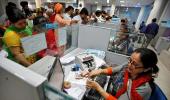For now, the concerns over bad loans have taken a back seat; a bigger challenge for the banking community is credit growth, explains Tamal Bandyopadhyay.

The credit deposit ratio of the Indian banking industry in the fortnight ending August 13 was 69.92.
This means for every Rs 100 worth of deposits, the banking system has lent Rs 69.92.
Is this too low? A year ago, in mid-August 2020, the CD ratio was 72.06.
The mid-August CD ratio is the lowest since the fortnight ending December 9, 2016, during the time of demonetisation, when it dropped to 69.29 per cent.
Barring this aberration, in the past decade, since 2011, the CD ratio roughly varied between 72 and 78 (August 2013).
Under norms, for every Rs 100 worth of net demand and time liability, a loose proxy for deposits, banks keep Rs 4 with the Reserve Bank of India as cash reserve ratio, on which they don't earn any interest.
Besides, at least Rs 18 needs to be invested in government bonds.
So, a bank can lend as much as Rs 78 out of a Rs 100 deposit.
They can and do lend even more, borrowing from the market and using capital.
While 69.92 is the industry average, not every bank is seeing such a low CD ratio.
A few private banks have much higher CD ratio, while most public sector banks' CD ratio is low.
Till recently, suffering from ill health, three of them were restrained by the RBI on giving fresh loans.
UCO Bank got out of it recently.
If the current CD ratio is an indication, the Indian economy cannot be on the cusp of a major boom.
Early last decade, in the aftermath of the global financial crisis, triggered by the fall of US investment bank Lehman Brothers Holdings Inc, Indian banks, swimming in liquidity, had splurged in indiscriminate lending.
That had led to a serious mispricing of risks.
The pile of bad assets rose, forcing the RBI to launch the first-of-its-kind asset quality review (AQR) of banks, a unique clean-up drive.
Most banks have been able to absorb the shock of the first wave of the Covid pandemic with relative ease because of their balance sheet strength post-AQR but a different kind of mispricing of risks is seen today, which could land them in trouble.
Banks are lending short term at 4-5 per cent, discounting bills and other ways — unheard of till now.
They are grabbing with both hands any opportunity to earn more than the reverse repo rate (3.35 per cent) and variable rate reverse repo auction rate (3.40 per cent was the rate for the last auction).
The risk premium is being compressed; the difference in the cost of money for good and not-so-good borrowers is narrowing.
To be sure, this is a global phenomenon now -- junk bonds in the US have never gone so cheap.
Between daily reverse repo and fortnightly variable rate reverse repo, the banking system has been parking Rs 7 trillion-Rs 8 trillion with the RBI.
Since mid-January, the variable rate reverse repo auction has been absorbing Rs 2 trillion every fortnight.
From mid-August, the quantum has been raised in phases; by September-end, this window will absorb Rs 4 trillion.
As on August 13, the deposit portfolio of the industry was Rs 155.7 trillion and the credit portfolio close to Rs 109 trillion.
The year-on-year growth of the deposit portfolio has been 10.6 per cent.
The credit growth, on a smaller base, has been 6.5 per cent.
In the current financial year so far, the deposit pile has grown 3 per cent, while credit pie dropped 0.6 per cent.
The low CD ratio is a reflection of this.
The struggle for most banks at this point is pushing credit growth to earn more.
How do they plan to do it?
As of July 30, corporate loans have grown just 1 per cent over the past year but loans to large businesses have shrunk 2.9 per cent.
In contrast, retail loans have grown 11.2 per cent during this period.
In this segment, gold loans glitter. They are growing at 77.4 per cent, although on a low base.
Banks are also aggressively chasing mortgage customers, charging the lowest-ever interest rate seen during the festive season.
For now, the concerns over bad loans have taken a back seat; a bigger challenge for the banking community is credit growth.
Chasing credit, banks are venturing into new pastures.
One of them is supply chain financing.
It is safe as loans are typically backed by invoices usually paid in weeks or months.
Financing supply chain, a big business in China, is based on genuine transactions; it offers financial solutions besides money.
The Covid pandemic has changed the way business is done in India.
While suppliers to large manufacturing companies and fast-moving consumer goods outfits continue to wait for weeks and months for their payment, dealers who buy the finished goods don't get credit anymore.
Most companies have introduced the cash-and-carry model; dealers need to pay manufacturers upfront.
Banks see a big opportunity here. While manufacturers are cutting down exposure to banks, dealers need money -- working capital.
Bankers are supporting both the suppliers and buyers of finished goods, covering the entire supply chain.
Banks are reaching out to the fund-starved micro, small and medium enterprises through this route.
They are also tapping the small and medium enterprises through the co-lending model where two lenders -- a bank and a non-banking financial company -- come together to disburse loans.
Going by the RBI norms, the banks and NBFCs involved in the business of co-lending share the risks and the rewards between them; the NBFCs that source such loans take at least 20 per cent exposure to the borrowers.
They cannot take loans from the partnering banks to finance their share of loans.
The NBFC identifies the borrowers, does credit appraisals and disburses a small part of the loan amount.
The partner bank lends the rest, but the NBFC collects repayment of instalments and earns a fee, besides the interest income.
Banks are also joining hands with fintech firms for co-lending.
Such exposures as well as export credit, which has been growing well, are part of the priority sector loans which, under the RBI norms, must be at least 40 per cent of a bank's credit.
Under pressure to boost earnings, Indian banks are exploring new avenues to lend but there are bigger challenges.
Feature Presentation: Aslam Hunani/Rediff.com
Tamal Bandyopadhyay, a consulting editor with Business Standard, is an author and senior adviser to Jana Small Finance Bank Ltd.












 © 2025
© 2025